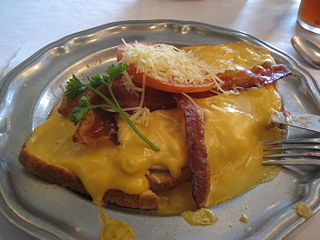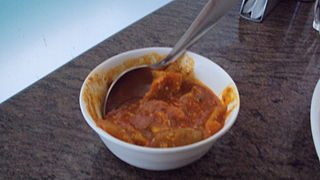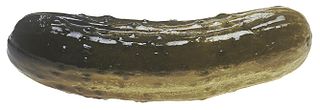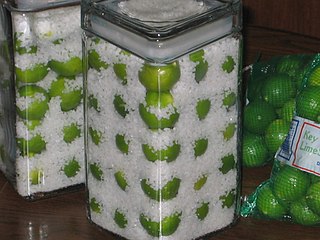Pickled oysters are a traditional way of preserving oysters by pickling or curing. To pickle oysters, they are usually cooked for a short period after removal from the shell, cooled, and placed in glass jars with vinegar and other spices. [1] [2]
In 1646, Humphrey Mill described pickled oysters being served to customers in brothels in England. [3] Another early reference to pickled oysters appears in the writings of Samuel Pepys, who wrote about them as early as 1661. [4]
According to Rowan Jacobsen, pickled oysters were "standard fare in every city on the Eastern Seaboard in that heady pre-canning era when oysters were in demand far and wide." [5] Pickled oysters were a popular dish among both the upper and lower classes. [6] [7] Pickled oysters were also served at the Governor’s Palace in Williamsburg, Virginia. [8] In Colonial America, pickled oysters were a commonly traded commodity as a part of the slave trade. [9] The papers of George Washington indicate that he enjoyed pickled oysters in the 1780s and received them as a gift. [10]
In the 1840s and 1850s, Thomas Downing served pickled oysters at his establishment in New York City. [11]
In 1881, U.S. President James A. Garfield's inauguration dinner included over 100 gallons of pickled oysters. [12] Victorian-era cookbooks often include pickled oyster recipes. [13] [14]
Pickled oysters were a frequent holiday staple in American homes of the 1800s. [15] [16] [17]
The 1903 Le guide culinaire includes a pickled oyster preparation. Pickled oysters are still a common staple in Southern cuisine of the United States, and have been a featured recipe by Mashama Bailey and Thomas Keller. [18] [19]

The cuisine of the Southern United States encompasses diverse food traditions of several subregions, including Tidewater, Appalachian, Ozarks, Lowcountry, Cajun, Creole, and Floribbean cuisine. In recent history, elements of Southern cuisine have spread to other parts of the United States, influencing other types of American cuisine.

Oyster is the common name for a number of different families of salt-water bivalve molluscs that live in marine or brackish habitats. In some species, the valves are highly calcified, and many are somewhat irregular in shape. Many, but not all oysters, are in the superfamily Ostreoidea.

A chutney is a spread typically associated with cuisines of the Indian subcontinent. Chutneys are made in a wide variety of forms, such as a tomato relish, a ground peanut garnish, yogurt or curd, cucumber, spicy coconut, spicy onion or mint dipping sauce.

The eastern oyster —also called the Atlantic oyster, American oyster, or East Coast oyster—is a species of true oyster native to eastern North and South America. Other names in local or culinary use include the Wellfleet oyster, Virginia oyster, Malpeque oyster, Blue Pointoyster, Chesapeake Bay oyster, and Apalachicola oyster. C. virginica ranges from northern New Brunswick south through parts of the West Indies to Venezuela. It is farmed in all of the Maritime provinces of Canada and all Eastern Seaboard and Gulf states of the United States, as well as Puget Sound, Washington, where it is known as the Totten Inlet Virginica. It was introduced to the Hawaiian Islands in the 19th century and is common in Pearl Harbor.

A relish is a cooked and pickled product made of chopped vegetables, fruits or herbs and is a food item typically used as a condiment to enhance a staple. Examples are chutneys and the North American relish, a pickled cucumber jam eaten with hot dogs. In North America, the word "relish" is frequently used to describe a single variety of finely chopped pickled cucumber relish, such as pickle, dill and sweet relishes.

Chow-chow is a North American pickled relish.

Pickling is the process of preserving or extending the shelf life of food by either anaerobic fermentation in brine or immersion in vinegar. The pickling procedure typically affects the food's texture and flavor. The resulting food is called a pickle, or, if named, the name is prefaced with the word, 'pickled'. Foods that are pickled include vegetables, fruits, mushrooms, meats, fish, dairy and eggs.

The cuisine of Kentucky mostly resembles and is a part of traditional Southern cuisine. Some common dinner dishes are fried catfish and hushpuppies, fried chicken and country fried steak. These are usually served with vegetables such as green beans, greens, pinto beans slow-cooked with pork as seasoning and served with cornbread. Other popular items include fried green tomatoes, cheese grits, corn pudding, fried okra, and chicken and dumplings, which can be found across the commonwealth.

South Asian pickle is a pickled food made from a variety of vegetables and fruits preserved in brine, vinegar, edible oils, and various South Asian spices. The pickles are popular across South Asia, with many regional variants, natively known as lonache, avalehikā, uppinakaayi, pachadi or noncha, achaar, athāṇu or athāṇo or athāna, khaṭāī or khaṭāin, sandhan or sendhan or sāṇdhāṇo, kasundi, or oorugaai.
Salmagundi is a cold dish or salad made from different ingredients which may include meat, seafood, eggs, cooked and raw vegetables, fruits, or pickles. In English culture, the term does not refer to a single recipe but describes the grand presentation of a large plated salad of many disparate ingredients. These can be arranged in layers or geometrical designs on a plate or mixed. The ingredients are then drizzled with a dressing. The dish includes a wide range of flavours and colours and textures on a single plate. Often recipes allow the cook to add various ingredients which may be available at hand, producing many variations of the dish. Flowers from broom and sweet violet were often used.

Pickled eggs are typically hard-boiled eggs that are cured in vinegar or brine. As with many foods, this was originally a way to preserve the food so that it could be eaten months later. Pickled eggs have since become a favorite among many as a snack or hors d'œuvre popular in pubs, bars, and taverns, and around the world in places where beer is served.

Pickled walnuts are a traditional English pickle, made from walnuts. They are considered a suitable accompaniment for a dish of cold turkey or ham, as well as blue cheese. There is a reference to "a mutton chop and a pickled walnut" in The Pickwick Papers by Charles Dickens and a mention in Evelyn Waugh’s Brideshead Revisited.

A pickled cucumber – commonly known as a pickle in the United States and Canada and traditionally a gherkin in Britain, Ireland, South Africa, Australia, and New Zealand – is a usually small or miniature cucumber that has been pickled in a brine, vinegar, or other solution and left to ferment. The fermentation process is executed either by immersing the cucumbers in an acidic solution or through souring by lacto-fermentation. Pickled cucumbers are often part of mixed pickles.

Pickled fruit refers to fruit that has been pickled. Pickling is the process of food preservation by either anaerobic fermentation in brine or immersion in vinegar. Many types of fruit are pickled. Some examples include peaches, apples, crabapples, pears, plums, grapes, currants, tomatoes and olives. Vinegar may also be prepared from fruit, such as apple cider vinegar.
The Oyster Recovery Partnership (ORP) is a 501(c)(3) nonprofit organization that leads conservation efforts of the native Eastern oyster, Crassostrea virginica, in the Chesapeake Bay and Eastern United States. The organization's activities and programs include oyster restoration, shell recycling conservation, and sustainable fishery initiatives.
Bevans Oyster Company is an oyster farm and seafood aquaculture company headquartered in Westmoreland County, Virginia. The company has been described as one of the largest oyster companies in the State of Virginia.